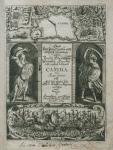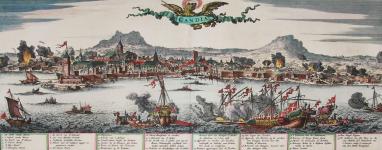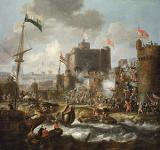

1648
: When the Ottomans,
with Gaze Hussein Pasha at the head, arrived in
front of the huge city walls, they didn’t attack the city wright away. Their
heavy canons had to be debarked in Chania and pulled by captives through the
mountain trails of the northern coast to Candia, since no secure place of
debarkation existed in the vicinity of the city. Until then they camped to the
West of the Fortress, by the river Giofyros, and begun to be prepared for the
siege.
They
started by cutting off the water supply of the Morosini aqueduct, which had its
springs by the village of Archanes. They also tried to reach the Fortress
through burrows dug by special under-miners, such as Armenian gold-miners, parallel
to the section of the wall that they tried to reach. The method failed, since
they were not yet familiar with it. The tactic of undermining by the besiegers
and cross-undermining by the besieged, as well as
the merciless
bombarding, would be the main characteristics of
the siege of the largest defensive work of the Eastern Mediterranean.
Heavy
canons arrived in March 1648 and were installed on the hills around the city.
For the next 21 years the only way out for the besieged citizens of Candia
would be the sea. The Ottomans initially chose to attack the Fortress from the
South and southeast,
which was the section of the most powerful bastions (Vitturi, Jesu,
Martinengo), since they thought erroneously that the higher level of the ground
outside the moat should give them an advantage. The first severe attack in June
1648 was successfully confronted by the defenders of the external fortress of
St. Demetrius. But damages were caused to the spear and the body of the
Martinengo bastion, helping the Ottomans to climb for a while on the bastion,
before they were repelled. Damages were also caused to the flank of the Jesu
bastion. The curtain wall between the bastions of Jesu and Vitturi was fiercely
bombarded but not conquered.
After
his failure, Hussein withdrew his army to the hills
of Marathitis, were he set a camp. The defenders made repairs to the walls and
constructed additional defensive works during the winter.
1649: Attacks
were repeated from August to early October of the next year, against the same
parts of the walls and the SW side of the Fortress, from the bastion of
Martinengo to the bastion of the Pantokrator (Panigra) without any success. In
the beginning of the winter the Ottomans were withdrawn, realizing that the
conquest of Candia would not be an easy case. Since this would be a
long-lasting siege, they decided to construct permanent bases and shelters to
be protected by counterattacks.
In the 28th of February
1649 the Sultan ordered the construction of three small fortresses around the
walls of Candia, one to the East, near the lazaretto, one to the South and one
West of the river Giofyros. At the same time begun the construction of the
fourth, larger fortress, which
was to act as the headquarters, on the hills of Brussa, the actual
village of Fortezza, which took its modern name by the fortress itself. The
fortress was called Enantia or New Candia or Inadiye or Kale-I-Cedit (New
Fortress), but the construction was negligent.
1649-1666: From
1649 to 1666 generated war inactivity occurred. The city remained besieged and
the only breakthrough, which was the sea, became more and more hard. In 1666
the situation was suddenly changed. The Sultan had already recalled Hussein, he
had taken his head off as being responsible for the failure of the siege and he
had replaced him with Köprülü Mehmed Pasha, the so-called Faisal (fair), a
skillful, ambitious and cruel man, which was meant
to be the fatal person for the city. Against him should stand Francesco
Morosini, the efficient general of the city’s army
and the most powerful fortress
in the Mediterranean Sea. The dramatic epilogue of the siege had already begun
to be written.
Köprülü debarked in Chania
in early November 1666 and arrived in Candia soon after that. Until the next
spring he made careful preparations, moving his headquarters to the fortress of
Giofyros, which he protected from the East with a moat, fortifying the areas of
his powder guns, creating a smelter of cannons near Cnossos and a powder manufacture
near Fortezza and ensuring the supply of his troops from the harbors of
Tsoutsouros, Matala and Ierapetra.
1667: In the
28th of May 1667 Köprülü attacked the SW side of the Fortress, from the bastion of
Martinengo to the bastion of St. Andrew, with 300 canons. The Ottomans managed
to destroy the wall holding the bank of the moat opposite the bastion of
Pantokrator, to occupy the external fortress and to enter to the moat in front
of the bastion, which was now under deep pressure. The attacks went on and on
until November.
In the 15th of
November 1667 the Venetian mechanic Andrea Barozzi defected to the Ottoman side
and provided Köprülü with details on the construction and status of the walls,
revealing the weakness of the two sea-side bastions, the Sabbionara bastion and
the bastion of St. Andrew. These two bastions, due to their position, were not
complete, since they possessed one lobe and one low terrace for canons each ; they were lower than the
rest and most of all, they could not be cross-undermined by the defenders since
the bastion of St. Andrew was constructed on a rocky ground and the bastion of
Sabbionara on the sandy beach. Barozzi also consulted the Ottomans on the
undermining method.
Under Barozzi’s instructions
the Ottomans revised their attacking attitude and turned their gun forces
towards the northern edges of the inland walls. Ιn the 10th of
November 1667 the bombarding of the bastion of St. Andrew begun. By the 10th
of December, external fortresses begun to be constructed opposite the two
sea-side bastions. The besieged understood the change of the attacking attitude
and tried to take defensive measures, without success. The defenders were by
then both outnumbered and exhausted.
1668: In the
11th of June 1668 a new attack was fired, this time against the
bastion of Sabbionara, causing a breakage of 140m. in wideness on his flank. In
respect, a breakage of 160 m. was caused on the bastion of St. Andrew. The
defenders tried
to construct retreat dikes.
1669: By January 1669 the situation for
the besieged was tragic. The bastion of St. Andrew and the first dike of
defense, the so-called “wall
of the Frenchmen”, were
conquered by the Ottomans and the defenders had retreat behind the second dike
of defense. On the bastion of Sabbionara, in the place of the flag of St. Marc,
the flag with the double ax, the emblem of the Janissaries, was weaving. Soon
the flags of the seven Janissary troops, the famous “Seven Axes” should be on
the bastion and to the west of it. The second defense dike broke as well.
The
city of Candia was doomed. The heroic sortie of the French, who run to help
under the admiral Duke de Beaufort and Duke de Navailles failed, as did the
bombarding of the ottoman troops by the fleet of the Christian forces. The
detonation that sunk the flagship “La Thérèse” put an end to the effort.
Trying
to avoid the plundering and the massacre, the
last heroic defender of Candia Francesco Morosini chose the capitulation.
According to the terms of the treaty, signed after long and hard negotiations
in the 16th of September 1669, Venetians surrendered the island to
the Ottomans, except for the fortresses of Grambussa, Suda and Spinalonga and
in return the citizens of Candia should be given the time to abandon the city,
carrying with them their guns, their treasures and their documents. Thanks to
this deal the valuable state archives of Candia were safely transferred to
Venice. Later Morosini was accused by the State of Venice of betrayal, to be
finally declared innocent. Nevertheless, the love for the city he defensed for
21 years can be easily estimated by the Cretan symbols on his flag, designed by
the famous Cretan painter Victor, actually exhibited in the Museum of Corer in
Venice, and the donation of his coat-of-arms and crown to the Virgin
Messopantitissa, the miraculous icon of Candia, which was also transferred to
Venice and it is hosted today in the church of Santa Maria della Salute.
When
the Ottoman troops entered Candia in the 4th of October 1669 the
city was empty. The cost of the loss in the mind of Candia’s citizens, who were
forced to abandon it after 21 years of siege, hunger, thirst and furious
resistance, can be counted only through the mourning poetry. Perhaps no other
city in men’s history was praised and mourned as much as did Candia in the
poetry of Manuel Zane Bounialis:
Oh
my glorious Castle, I wander if those who survived
are mourning and feeling
homesick for you.
All citizens of Candia should be dressed in black
every day they should mourn and they should
never sing
men,
women and boys and every girl
they ought to show
that they lost such a homeland.
 | 5. The “Cretan War” | |
|---|---|---|
 | 5.2 Cretan War and sank of La Thérèse | |
 | 5.3 The evacuation of Candia | |
 | 5.4 The Cretan War in the Literature | |
 | 5.4.1 Anthimos (Akakios) Diakrousis | |
 | 5.4.2 Marinos Tzanes Bounialis |